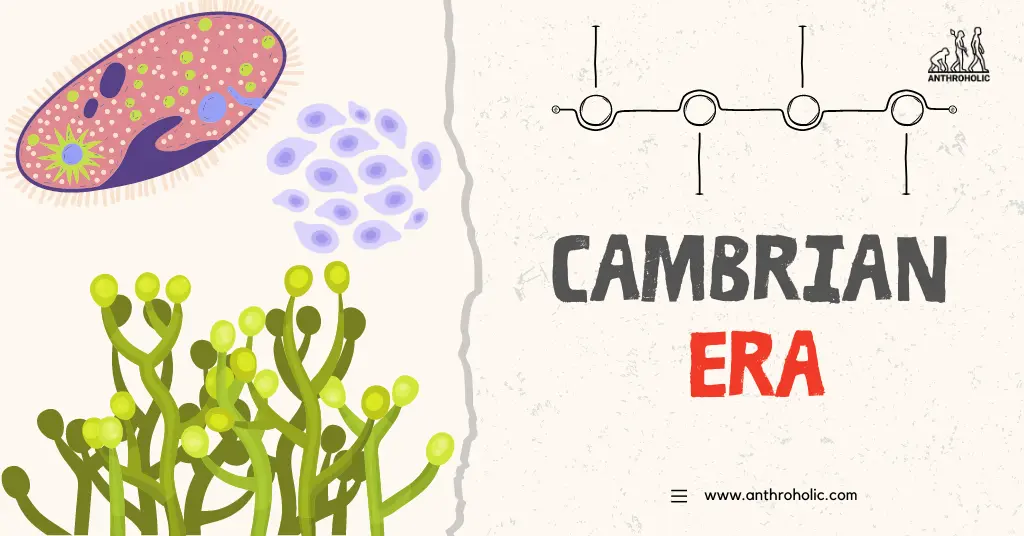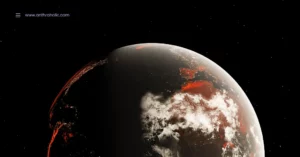AI Answer Evaluation Platform Live Now. Try Free Answer Evaluation Now
Cambrian Era
The Cambrian Period, roughly 541 to 485.4 million years ago, marks a significant era in the history of life on Earth [1]. During this time, a remarkable explosion of diversity occurred, with the first appearance of many multicellular organisms and early forms of many major groups of animals alive today.

Overview of the Cambrian Era
The Cambrian era lasted about 55.6 million years, kicking off the Paleozoic era, the “time of ancient life”. Fossil evidence from this period shows a sudden appearance of a diverse array of multicellular organisms, with hard shells and exoskeletons [2]. This event, known as the Cambrian Explosion, is one of the most significant evolutionary events in Earth’s history.
Key features of the Cambrian Era:
- The first appearance of many major groups of complex animals.
- Rapid evolution and diversification of life forms, a phenomenon known as the Cambrian Explosion.
- The formation of the supercontinent Gondwana.
- A warm climate with high sea levels and shallow continental seas [2].
The Cambrian Explosion
The Cambrian Explosion, occurring around 540 million years ago, was a time of rapid evolution. Over a relatively short geological time frame, most of the major groups of animals first appeared [3].
Some key points about the Cambrian Explosion include:
- Diverse Life Forms: Before the Cambrian Explosion, most organisms were simple, composed of individual cells occasionally organized into colonies. After the explosion, the variety of life forms significantly increased, with the first appearances of arthropods, mollusks, brachiopods, and annelids [4].
- Hard Shells and Exoskeletons: The fossil record of the Cambrian period is abundant due to the evolution of hard shells and exoskeletons, which fossilize well. Prior to this, most organisms were soft-bodied and left fewer traces.
- First Predators: The Cambrian period also saw the appearance of the first predators, which led to the evolution of defensive structures in prey, thus adding to the diversification of life [5].
| Organisms | First Appeared in the Cambrian |
|---|---|
| Arthropods | Yes |
| Mollusks | Yes |
| Brachiopods | Yes |
| Annelids | Yes |
Climate and Geography
The Cambrian era was a time of significant geological activity. This activity resulted in the formation of the supercontinent Gondwana, composed of most of the landmasses in today’s Southern Hemisphere, including South America, Africa, Australia, and Antarctica [6].
During the Cambrian period, the climate was generally warm, with high sea levels and no evidence of glaciation. The high sea levels and the abundance of shallow, warm seas provided ideal conditions for marine invertebrates to flourish [7].
Legacy of the Cambrian Era
The Cambrian era set the stage for the evolution of life as we know it today. Many of the animal phyla present in the modern world trace their roots back to this time [8].
The Cambrian fossil record also allows scientists to study early forms of life, providing insight into evolutionary processes and how complex organisms and ecosystems developed.
Notable fossil sites include:
- Burgess Shale in Canada: This site has provided some of the best preserved and diverse Cambrian fossils, including many soft-bodied organisms [9].
- Chengjiang in China: This site has also yielded a diverse array of early Cambrian fossils, giving us a glimpse into the marine ecosystems of the time [10].
Cambrian Life: A Closer Look
While the Cambrian explosion marked the appearance of a majority of the major groups of complex animals, several particular groups are notable for their impact on the Cambrian ecosystem and the future of life on Earth.
Trilobites
Among the most successful and iconic Cambrian organisms were the trilobites [11]. Trilobites were a class of early arthropods that emerged in the Early Cambrian and thrived throughout the Paleozoic era. They had a segmented body protected by an exoskeleton, which facilitated their fossilization.
The rapid diversification and widespread distribution of trilobites make them invaluable for correlating the age of rocks in different locations and for studying Cambrian marine ecosystems.
Anomalocaridids
Anomalocaridids were large, predatory marine animals that emerged in the Early Cambrian [12]. They were among the first apex predators and played a significant role in shaping early marine ecosystems. Their existence provides insight into the development of complex predator-prey relationships.
Small Shelly Fossils
Small Shelly Fossils (SSFs) are a diverse group of early skeletal fossils. These include the first shells, spines, and other hard parts produced by animals. SSFs demonstrate the onset of biomineralization, marking an important evolutionary milestone.
The End of the Cambrian Era
The Cambrian era ended about 485.4 million years ago, marking the beginning of the Ordovician period. This transition was characterized by the mass extinction known as the Cambrian-Ordovician extinction event, resulting in a significant loss of biodiversity [13].
Despite the abrupt end, the innovations and rapid diversification of life during the Cambrian era left a lasting legacy. The impact on the Earth’s biosphere was immense, setting the stage for the evolution of modern ecosystems.
In conclusion, the Cambrian Era marked a pivotal moment in Earth’s biological history. The rapid diversification of life, formation of hard shells, and advent of predation fundamentally reshaped the Earth’s ecosystems, setting the stage for the subsequent evolution of life.
References
[1] “Cambrian.” Encyclopædia Britannica, https://www.britannica.com/science/Cambrian-Period
[2] “Paleozoic Era: Facts & Information.” Live Science, https://www.livescience.com/37584-paleozoic-era.html
[3] “The Cambrian Explosion.” Smithsonian National Museum of Natural History,
[4] Marshall, C.R., Explaining the Cambrian “Explosion” of Animals. Annual Review of Earth and Planetary Sciences 2014. 34: 355-384, https://www.annualreviews.org/doi/10.1146/annurev.earth.33.031504.103001
[5] Peterson, K.J. et al., The Ediacaran emergence of bilaterians: congruence between the genetic and the geological fossil records. Philosophical Transactions of the Royal Society B: Biological Sciences. 2008. 363: 1435–1443, https://royalsocietypublishing.org/doi/10.1098/rstb.2007.2233
[6] Torsvik, T.H. & Cocks, L.R.M., Gondwana from top to base in space and time. Gondwana Research. 2013. 24: 999–1030, https://doi.org/10.1016/j.gr.2013.06.012
[7] Saltzman, M.R. & Thomas, E., Carbon isotope stratigraphy. In: James, N.P., Dalrymple, R.W. (Eds.), Facies Models 4. Geological Association of Canada, St. John’s, Newfoundland, 2010, pp. 207-232.
[8] Erwin, D.H., The Cambrian conundrum: early divergence and later ecological success in the early history of animals. Science. 2011. 334: 1091–1097, https://doi.org/10.1126/science.1206375
[9] “The Burgess Shale.” The Burgess Shale Geoscience Foundation, https://burgess-shale.rom.on.ca/
[10] Hou, X.G., Aldridge, R.J., Bergstrom, J., Siveter, D.J., Siveter, D.J., & Feng, X.H., The Cambrian Fossils of Chengjiang, China: The Flowering of Early Animal Life. Wiley-Blackwell, 2004.
[11] Fortey, R. A. “Trilobite!” Harper Collins, 2000.
[12] Daley, Allison C., and Graham E. Budd. “New anomalocaridid appendages from the Burgess Shale, Canada.” Palaeontology 53, no. 4 (2010): 721-738. https://onlinelibrary.wiley.com/doi/full/10.1111/j.1475-4983.2010.00955.x
[13] Kröger, B., Servais, T., & Zhang, Y. “The Origin and Initial Rise of Pelagic Cephalopods in the Ordovician.” PLOS ONE 3, no. 10 (2008). https://doi.org/10.1371/journal.pone.0003196




